Sustainable City 2013
8th International Conference on Urban Regeneration and Sustainability
![]() 3 - 5 December 2013
3 - 5 December 2013
Putrajaya, Malaysia
Overview
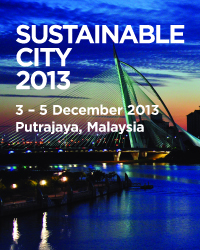
The 8th International Conference on Urban Regeneration and Sustainability (Sustainable City 2013) took place in Malaysia, organised by the Wessex Institute, UK and the University of Teknologi Mara, Malaysia. The meeting, which took place in the Putrajaya Pullman Hotel, was sponsored by P J Holdings.
The city of Putrajaya was the brainchild of former Prime Minister Tun Dr Mahathir Mohammad who officially declared it the new administrative centre of the Federal Government of Malaysia in 1997. Putrajaya, planned as a Garden City, playing a balance of Man and Nature, was conceived as the City of the future. It covers an area of nearly 15,000 ha with 30% of it the Administrative core. When completed, the population is expected to exceed half a million.
The conference venue was the Pullman Putrajaya Hotel. The hotel's architecture is inspired from the fusion of the various prevailing vernacular architectural styles and ambiances of Malaysia. The premises offered all modern facilities and excellent conference rooms.
The Conference was opened by Prof Carlos A Brebbia, Co-Chair of the Sustainable City meeting and Director of the Wessex Institute. He thanked the Universiti Teknologi Mara for the support and, in particular, to Dr Azni Zairi Ahmed. Carlos referred to the excellent links that WIT has with Mara University.
“This is the second meeting we have co-organised with the University. The first conference last year was also most successful, co-chaired like this by Prof Syed Zubir, whose enthusiasm and hard work has contributed so much to making this a very successful conference.”
“I would like to think that this conference will be a first step for our Institute to develop close links with Mara as well as other Malaysian Institutions. Some of our graduates are now occupying positions of responsibility in academia in this country and we have also worked with industrial enterprises in the field of offshore engineering.”
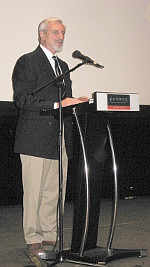
Prof. Brebbia
“Carlos then referred to the work of the Wessex Institute, which acts as a medium for the transfer of knowledge. He described the different activities of WIT, starting with its research, and the development of powerful computational tools. This work, started many years ago, has been well received by industry, and the advanced consulting and new developments continually being requested contributes to WIT maintaining its leadership in computational methods, particularly with the boundary element, a technique widely recognised as being developed at the Institute. This part of WIT activities is also rewarding – Carlos said – in terms of validation of the research carried out at the Institute which demonstrated its application in engineering practice.”
“Another part of the activities taking place at WIT is the publication of books – including those resulting from conferences such as this – and Journals. The production is carried out in hard cover as well as electronic form. Papers presented at WIT conferences are widely distributed through the book and permanently archived in the Wessx Institute eLibrary (http://library.witpress.com). This gives the greatest visibility to all papers.
Furthermore, all presenters are encouraged to extend their papers for submission to one of the Journals run by the Institute. In the case of this conference, the most appropriate Journals being the International Journal of Sustainable Development and Planning andthe International Journal of Design & Nature and Ecodynamics.
“Carlos then referred to the importance of the conferences in terms not only of interchange of information during the sessions but also because of the many contacts made during the meetings, leading to joint reports, new publications and other interactions. The conference programme of WIT consists of approximately 25 meetings per year, covering a wide range of topics, with emphasis on interdisciplinary fields.
“As urban populations increase, we need to investigate new solutions for our cities in order to achieve long term sustainability. That is why the experience of Putrajaya is so important and a suitable venue for our meeting.
Malaysia continues to develop, and from rather modest beginnings not so long ago, it has now reached a position of prominence in the world.
The conference objective is also to interchange information in research to understand the ways different countries are developing their cities and in this manner learn from each other and reach optimum solutions.
Conferences such as this are part of the work of the Institute in order to fulfil our objectives.
Carlos concluded by thanking his Co-chair Professor Syed Zubir of the Universiti Teknologi Mara, whose work has been essential to the success of the conference.
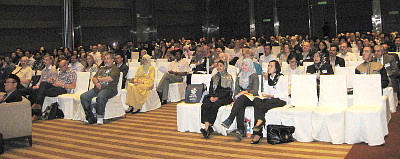 Delegates during the conference
Delegates during the conferenceWelcome by Prof Azni Zairi Ahmed
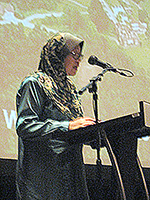
Prof. Azni Zairi Ahmed
Professor Azni Zairi Ahmed then welcomed the delegates on behalf of Universiti Teknologi Mara, explaining that the University was happy to be associated once more with WIT following the successful conference held in Kuala Lumpur two years ago. UTM is very much interested in sustainable architecture research and, in particular, in city sustainability. It is essential to improve the quality of buildings to ensure that energy is not wasted and the architectural heritage will last for future generations.
Professer Ahmed then said “It is a great honour for me to speak on behalf of Universiti Teknologi MARA at this International Conference on Urban Regeneration and Sustainability. On behalf of Universiti Teknologi MARA, affectionately known here as UiTM, I congratulate the Chairmen and their organising committee for putting this issue of urban regeneration and sustainability high in the international research agenda.
“The gathering here at Putrajaya is thus very timely and very befitting. As a new administrative capital city, Putrajaya has been developed to incorporate the concept of a Green Township. This concept is consistent with Malaysia’s National Policy on Climate Change and National Green Technology Policy. What this means is that Putrajaya’s development must be able to adapt and mitigate climate change through the application of green technology, establishment of society’s coping-limit as well as town planning that is integrated with disaster risk reduction measures. These aspects are obviously directly related to the topics in the call for papers of this conference. It is therefore very encouraging to know that international paper presenters and participants from at least thirty five countries are represented here today to share your professional experiences and research expertise on this matter. I believe that your input will contribute tremendously in Putrajaya’s pledge as a Role Model City under the auspices of the United Nations International Strategy for Disaster Reduction Secretariat (UNISDR).
“I am pleased to note that this conference is the second occasion of partnership between UiTM and Wessex Institute of Technology (WIT). The inaugural conference was held two years ago on our campus in Shah Alam. This happy long-distance marriage, if I could term the partnership between UiTM and WIT as such, appears to be sustainable in its own right as plans are already on the way to jointly-organise another International conference here in Putrajaya next year in December 2014.
“As the Deputy Vice-Chancellor on Academic and International Affairs of UiTM, I beckon such a co-operation as a means to enriching our academic course contents. My own research interest and endeavours are closely related to aspects of environmental protection and sustainability. I would therefore share the commitment to ensure that UiTM will give the fullest support to the Faculty of Architecture, Planning and Surveying as a whole and specifically to the Centre of Studies for Architecture to deliberate on all areas of concern of this conference.
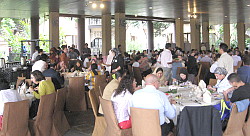
Delegates during lunch
“Building sustainable cities after all, is the task and concern of everybody, and must not be limited to any particular geography. Each of us stands not in isolation but as a symbiotic entity of the greater network and universe. I wish to call for this concern for building sustainable cities to be extended more rigorously to incorporate participation of the general public as well as primary and secondary level students. I believe all of us here today have the responsibility of leadership to raise the awareness of sustaining our cities and built environment worldwide. It cannot be repeated often enough that urbanization is the key factor that is transforming the faces of our globe. The only way to ensure that we will pass on a worthwhile inheritance to the coming generations is to begin with a legacy of building sustainable cities.”
At the end of her talk Professor Ahmed declared the conference open. Carlos then thanked her for her presence and the most suitable opening address. He offered her a copy of the book “The New Forest”, published by WIT Press, which gives an idea of the unique history of the area where the Institute is located. He also presented her with a piece of pottery specially made by a New Forest potter for the Institute, hoping that one day she will be able to visit WIT.
Conference Sessions
After the Preliminary session, the conference was run in three parallel sessions due to the large number of presentations. The generic titles of the sessions were:
- Urban metabolism
- Urban strategies
- Planning, development and management
- Transportation
- Sustainable tourism
- Environmental protection
- Sustainable energy and the city
- Solar-integrated systems
- Planning for risks and natural hazards
- Business solutions in developing countries
- Case studies
- Transforming buildings
- Cultural heritage issues
- The community and the city
- Landscape planning and design
- Waterfront development
- Quality of life
- Waste management
- Intelligent environments and emerging technologies
- Environmental management
Invited Presentations
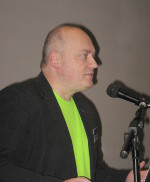
Prof. Barelowski
There were a number of invited presentations that contributed to enhance the meeting.
‘How different is different? Measuring diversity’ by Christian Cloete, University of Pretoria, South Africa.
‘Mobility and the role of the automobile as the central device in modern North American residential spatial planning’ by Andrew Furman, Ryerson University, Canada.
‘Sustainable aspect for safeguarding protected area case study: Siwa Oasis’ by Manal Yehta Tawfik, El Shoroukk Academy, Egypt.
‘Sustainability: myth, reality, future – planning and renewable energy management’ by Robert Barelowski, Polish Academy of Science, Poland.
‘Energy sustainability through integrated solar thermal systems’ by Hussain Al-Kaylem, University Teknologi Petronas, Malaysia.
Social Occasions
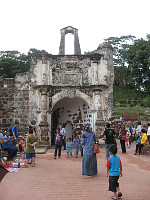
Excursion
The conference offered numerous occasions for the delegates to socialise and discuss issues of common interest in a relaxed atmosphere. They were offered excellent complimentary lunches, in addition to coffee breaks with sandwiches and fruit juices. A special dinner was organised at the end of the first day, to which all delegates and their partners were invited. All of these events encouraged communication and interchange of ideas amongst the delegates. The conference, as all WIT meetings, was characterised by its friendliness and the good will shown by the delegates, which helped to promote the right climate for the exchange of information.
The conference dinner presented another social occasion for the delegates to interact .The excellent food was accompanied by lively discussions in a relaxed atmosphere.
The International Scientific Advisory Committee (ISAC) meeting took place over dinner in a restaurant located on the lake shore and serving a series of excellent local and international dishes. The Committee discussed how the conference ought to be improved when reconvened, following the forthcoming Sustainable City meeting in Siena. New members of the Committee were nominated and WIT will be sending them, as well as to the rest of the ISAC, a formal letter of invitation in due course.
At the end of the conference the University of Teknologi Mara offered the delegates a complimentary excursion to the historic city of Melaka, which is considered one of the oldest cities in Malaysia. The Portuguese, the Dutch and the English have controlled the city for more than 450 years and left their imprint on its culture. The excursion comprised places such as Jonk Street with its many historical buildings; the Stadthuys town hall and governors’ residence, which is the oldest Dutch building in the East. They also saw the remains of A Formosa, a fort protecting the river built by the Portuguese and the oldest pieces of European Architecture in the whole of South East Asia.
Conference Proceedings
The proceedings of Sustainable City 2013 - The Sustainable City VIII, 1428pp (Print ISBN: 978-1-84564-746-9; eISBN: 978-1-84564-747-6) are available from WIT Press. Orders can be placed on the WIT Press web site at www.witpress.com or by email:
Papers from the conference will also be hosted online at the WIT eLibrary as Volume 179 of WIT Transactions on Ecology and the Environment (ISSN: 1746-4498, Digital ISSN 1743-3509). For more details visit the WIT eLibrary athttp://library.witpress.com

 Wessex Institute
Wessex Institute